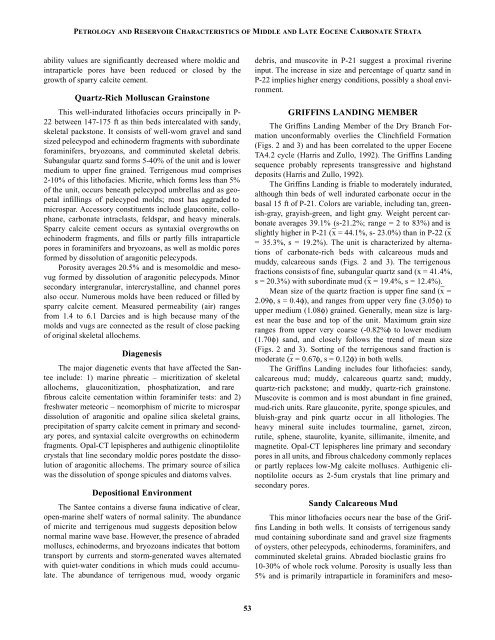Download Guidebook as .pdf (1.8 Mb) - Carolina Geological Society
Download Guidebook as .pdf (1.8 Mb) - Carolina Geological Society
Download Guidebook as .pdf (1.8 Mb) - Carolina Geological Society
Create successful ePaper yourself
Turn your PDF publications into a flip-book with our unique Google optimized e-Paper software.
PETROLOGY AND RESERVOIR CHARACTERISTICS OF MIDDLE AND LATE EOCENE CARBONATE STRATA<br />
ability values are significantly decre<strong>as</strong>ed where moldic and<br />
intraparticle pores have been reduced or closed by the<br />
growth of sparry calcite cement.<br />
Quartz-Rich Molluscan Grainstone<br />
This well-indurated lithofacies occurs principally in P-<br />
22 between 147-175 ft <strong>as</strong> thin beds intercalated with sandy,<br />
skeletal packstone. It consists of well-worn gravel and sand<br />
sized pelecypod and echinoderm fragments with subordinate<br />
foraminifers, bryozoans, and comminuted skeletal debris.<br />
Subangular quartz sand forms 5-40% of the unit and is lower<br />
medium to upper fine grained. Terrigenous mud comprises<br />
2-10% of this lithofacies. Micrite, which forms less than 5%<br />
of the unit, occurs beneath pelecypod umbrell<strong>as</strong> and <strong>as</strong> geopetal<br />
infillings of pelecypod molds; most h<strong>as</strong> aggraded to<br />
microspar. Accessory constituents include glauconite, collophane,<br />
carbonate intracl<strong>as</strong>ts, feldspar, and heavy minerals.<br />
Sparry calcite cement occurs <strong>as</strong> syntaxial overgrowths on<br />
echinoderm fragments, and fills or partly fills intraparticle<br />
pores in foraminifers and bryozoans, <strong>as</strong> well <strong>as</strong> moldic pores<br />
formed by dissolution of aragonitic pelecypods.<br />
Porosity averages 20.5% and is mesomoldic and mesovug<br />
formed by dissolution of aragonitic pelecypods. Minor<br />
secondary intergranular, intercrystalline, and channel pores<br />
also occur. Numerous molds have been reduced or filled by<br />
sparry calcite cement. Me<strong>as</strong>ured permeability (air) ranges<br />
from 1.4 to 6.1 Darcies and is high because many of the<br />
molds and vugs are connected <strong>as</strong> the result of close packing<br />
of original skeletal allochems.<br />
Diagenesis<br />
The major diagenetic events that have affected the Santee<br />
include: 1) marine phreatic – micritization of skeletal<br />
allochems, glauconitization, phosphatization, and rare<br />
fibrous calcite cementation within foraminifer tests: and 2)<br />
freshwater meteoric – neomorphism of micrite to microspar<br />
dissolution of aragonitic and opaline silica skeletal grains,<br />
precipitation of sparry calcite cement in primary and secondary<br />
pores, and syntaxial calcite overgrowths on echinoderm<br />
fragments. Opal-CT lepispheres and authigenic clinoptilolite<br />
crystals that line secondary moldic pores postdate the dissolution<br />
of aragonitic allochems. The primary source of silica<br />
w<strong>as</strong> the dissolution of sponge spicules and diatoms valves.<br />
Depositional Environment<br />
The Santee contains a diverse fauna indicative of clear,<br />
open-marine shelf waters of normal salinity. The abundance<br />
of micrite and terrigenous mud suggests deposition below<br />
normal marine wave b<strong>as</strong>e. However, the presence of abraded<br />
molluscs, echinoderms, and bryozoans indicates that bottom<br />
transport by currents and storm-generated waves alternated<br />
with quiet-water conditions in which muds could accumulate.<br />
The abundance of terrigenous mud, woody organic<br />
debris, and muscovite in P-21 suggest a proximal riverine<br />
input. The incre<strong>as</strong>e in size and percentage of quartz sand in<br />
P-22 implies higher energy conditions, possibly a shoal environment.<br />
GRIFFINS LANDING MEMBER<br />
The Griffins Landing Member of the Dry Branch Formation<br />
unconformably overlies the Clinchfield Formation<br />
(Figs. 2 and 3) and h<strong>as</strong> been correlated to the upper Eocene<br />
TA4.2 cycle (Harris and Zullo, 1992). The Griffins Landing<br />
sequence probably represents transgressive and highstand<br />
deposits (Harris and Zullo, 1992).<br />
The Griffins Landing is friable to moderately indurated,<br />
although thin beds of well indurated carbonate occur in the<br />
b<strong>as</strong>al 15 ft of P-21. Colors are variable, including tan, greenish-gray,<br />
grayish-green, and light gray. Weight percent carbonate<br />
averages 39.1% (s-21.2%; range = 2 to 83%) and is<br />
slightly higher in P-21 (x = 44.1%, s- 23.0%) than in P-22 (x<br />
= 35.3%, s = 19.2%). The unit is characterized by alternations<br />
of carbonate-rich beds with calcareous muds and<br />
muddy, calcareous sands (Figs. 2 and 3). The terrigenous<br />
fractions consists of fine, subangular quartz sand (x = 41.4%,<br />
s = 20.3%) with subordinate mud (x = 19.4%, s = 12.4%).<br />
Mean size of the quartz fraction is upper fine sand (x =<br />
2.09φ, s = 0.4φ), and ranges from upper very fine (3.05φ) to<br />
upper medium (1.08φ) grained. Generally, mean size is largest<br />
near the b<strong>as</strong>e and top of the unit. Maximum grain size<br />
ranges from upper very coarse (-0.82%φ to lower medium<br />
(1.70φ) sand, and closely follows the trend of mean size<br />
(Figs. 2 and 3). Sorting of the terrigenous sand fraction is<br />
moderate (x = 0.67φ, s = 0.12φ) in both wells.<br />
The Griffins Landing includes four lithofacies: sandy,<br />
calcareous mud; muddy, calcareous quartz sand; muddy,<br />
quartz-rich packstone; and muddy, quartz-rich grainstone.<br />
Muscovite is common and is most abundant in fine grained,<br />
mud-rich units. Rare glauconite, pyrite, sponge spicules, and<br />
bluish-gray and pink quartz occur in all lithologies. The<br />
heavy mineral suite includes tourmaline, garnet, zircon,<br />
rutile, sphene, staurolite, kyanite, sillimanite, ilmenite, and<br />
magnetite. Opal-CT lepispheres line primary and secondary<br />
pores in all units, and fibrous chalcedony commonly replaces<br />
or partly replaces low-Mg calcite molluscs. Authigenic clinoptilolite<br />
occurs <strong>as</strong> 2-5um crystals that line primary and<br />
secondary pores.<br />
Sandy Calcareous Mud<br />
This minor lithofacies occurs near the b<strong>as</strong>e of the Griffins<br />
Landing in both wells. It consists of terrigenous sandy<br />
mud containing subordinate sand and gravel size fragments<br />
of oysters, other pelecypods, echinoderms, foraminifers, and<br />
comminuted skeletal grains. Abraded biocl<strong>as</strong>tic grains fro<br />
10-30% of whole rock volume. Porosity is usually less than<br />
5% and is primarily intraparticle in foraminifers and meso-<br />
53













